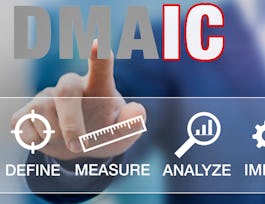This course will provide you will the tools necessary to complete the final components of the analyze phase as well as the improve and control phases of the Six Sigma DMAIC (Define, Measure, Analyze, Improve, and Control) process. This course is the final course in the Six Sigma Yellow Belt Specialization. You will learn about relationships from data using correlation and regression as well as the different hypothesis terms in hypothesis testing. This course will provide you with tools and techniques for improvement. You will also understand the importance of a control plan, as well as its key characteristics, for maintaining process improvements. Every module will include readings, discussions, lecture videos, and quizzes to help make sure you understand the material and concepts that are studied.



Six Sigma Tools for Improve and Control
This course is part of Six Sigma Yellow Belt Specialization



Instructors: David Cook, PhD
Sponsored by ITC-Infotech
47,487 already enrolled
(1,223 reviews)
Skills you'll gain
Details to know

Add to your LinkedIn profile
8 assignments
See how employees at top companies are mastering in-demand skills

Build your subject-matter expertise
- Learn new concepts from industry experts
- Gain a foundational understanding of a subject or tool
- Develop job-relevant skills with hands-on projects
- Earn a shareable career certificate


Earn a career certificate
Add this credential to your LinkedIn profile, resume, or CV
Share it on social media and in your performance review

There are 5 modules in this course
Welcome to Six Sigma Tools for Improve and Control! This is the fourth course in the Six Sigma Yellow Belt Specialization. Your team of instructors, Dr. Bill Bailey, Dr. David Cook, Dr. Christine Scherrer, and Dr. Gregory Wiles, currently work in the College of Engineering and Engineering Technology at Kennesaw State University. The next two modules will conclude the Analyze phase of the DMAIC process and in the final two modules you will be introduced to the Improve and Control phase. This module will continue to discussion analysis by explaining correlation and regression. You will learn the meaning of correlation and regression, the different types of analysis, and how it can be used in Six Sigma.
What's included
5 videos1 reading2 assignments
This the final module that covers the Analysis phase of the DMAIC process. Now that you have collected the data and calculated it you will need to determine how to make a statistical conclusion about your findings. In this module you will learn more about the importance of hypothesis testing, how to correctly do a hypothesis test reading as well as how to avoid errors, and statistical significance.
What's included
5 videos2 assignments
This module will introduce you to the Improve and Control phase of the DMAIC process. The first step in this phase is determining improvement techniques to help make improvements to an organization. This module will cover the best and most popular improvement techniques including kaizen and kaizen blitz, PDCA (Plan-Do-Check-Act) cycle, and cost benefit analysis (including cost of quality).
What's included
6 videos2 assignments1 discussion prompt
The final phase of the DMAIC process is the control phase. In this module you will learn about control tools that are useful in maintaining improvements. Communication is a key component of the control phase therefore it is important to develop standardized documentation. You will learn about how to standardize and manage documentation to help maintain processes that were implemented during the improve phase of DMAIC.
What's included
3 videos2 assignments
This module is the "capstone project." You should only complete this project if you have taken all three previous yellow belt specialization courses (Six Sigma Fundamentals, Six Sigma Tools for Define and Measure, and Six Sigma Tools for Analyze), AND you want to complete this specialization. It should be noted that completing the Yellow Belt Specialization does not give the learner "professional accreditation" in Six Sigma. However, successful completion will assist in better preparation for such professional accreditation testing.
What's included
1 reading1 peer review
Instructors


Offered by
Why people choose Coursera for their career




Learner reviews
1,223 reviews
- 5 stars
80.45%
- 4 stars
15.86%
- 3 stars
2.20%
- 2 stars
0.57%
- 1 star
0.89%
Showing 3 of 1223
Reviewed on Aug 28, 2020
Very useful course. Covers a plethora of tools helpful for six sigma and lean methodologies. Really loved it but could not catch up with the last course because of other activities.
Reviewed on Apr 5, 2022
Although this course is not easy course but the instructors were very proficient to simplify the materials to be understandable.
Reviewed on Jun 16, 2020
This course gives you a complete overview of what the DMIAC process is. The capstone project is really good because it makes you to utilize the knowledge gained from the previous courses.
Recommended if you're interested in Business

Kennesaw State University

Kennesaw State University

Kennesaw State University

Kennesaw State University

Open new doors with Coursera Plus
Unlimited access to 10,000+ world-class courses, hands-on projects, and job-ready certificate programs - all included in your subscription
Advance your career with an online degree
Earn a degree from world-class universities - 100% online
Join over 3,400 global companies that choose Coursera for Business
Upskill your employees to excel in the digital economy



